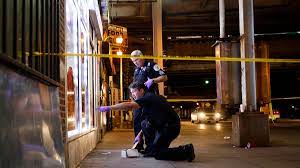Jens Ludwig & Chico Tillmon
Gun violence, at its highest level in the US since the early 1990s, has become one of the top concerns for many American voters. As a result, the country has debated reforms to policing, bail, sentencing and other aspects of our criminal justice system. But we’ve been ignoring an even more fundamental challenge: the gaping holes in our nation’s social safety net for the group at greatest risk of gun violence – young men.
If members of Congress truly want to address gun crime, they shouldn’t demand to cut spending and reduce the safety net, they should expand it. Gun violence in America is a problem driven by, and primarily affecting, working-age young men. According to the Federal Bureau of Investigation’s 2021 homicide data report, two-thirds of homicides were committed by a man and two-thirds of victims were male. Most of those involved in homicides are in their 20s and 30s.
To understand these patterns, imagine growing up a young man on Chicago’s West Side, in the predominantly Black community of Austin – as one of us did. (In Chicago, the median homicide victim is between the ages of 24 and 28.) Austin is a neighborhood swept up in the trend towards de-industrialization. Unemployment and poverty are rife. While it still has some of the most beautiful houses in the city, empty lots and boarded-up stores are increasingly common.
The rate of drug overdoses is among the highest in the city – particularly near the Eisenhower Expressway, connecting Chicago’s downtown to the suburbs, which is otherwise known as the “heroin highway.” Now imagine being in this environment – and cut off from most of the federal social safety net. As this safety net developed in the 1930s and expanded in the 1960s with programs like Social Security, disability benefits and food stamps, it rested on a crucial assumption: that working-age, able-bodied people would be employed and bringing in income for themselves and their families. In other words, the safety net worked on the principle that working-age men wouldn’t need one.
We can see the implications of that assumption in the eligibility criteria today for the largest federal social programs. In 12 states, able-bodied, working-age men and adults without children are not even eligible for one of the most widely-available safety net programs, Medicaid. And in every state, able-bodied, working-age-but-not-working single men (especially those who don’t have children in their household) get almost no help at all from many other significant social safety net programs: the Supplemental Nutritional Assistance Program (SNAP, i.e. food stamps), Temporary Assistance for Needy Families (TANF), Supplemental Security Income (SSI), the Earned Income Tax Credit (EITC) and Housing Choice Vouchers. We can also see the implications in the degree to which different population groups are lifted out of poverty by the federal safety net. Social Security cuts senior citizen poverty rates by 75%. Single-parent families benefit from reductions in poverty of 38% through programs that support them. But the percentage of working-age men lifted out of poverty by the safety net is remarkably modest.
Perhaps there was a time when the assumption that able-bodied young men would always be in the workforce made sense. But it’s not clear this is the case anymore. When we look at European countries like Greece and Italy and see that over one quarter of young people are neither in school nor working, we ask ourselves: What is structurally wrong with the labor market in those countries that would lead to so many people being disconnected from employment?
Similarly, when we look at modern-day American cities like Chicago – where the Chicago Sun-Times reports that 45% of Black men ages 18-24 are neither working nor in school – we must ask what sort of structural issues are causing problems here as well? For an answer, look at the disappearance of so much of Chicago’s manufacturing industry, which used to provide a middle-class wage for people of all schooling levels. In the 1950s, Chicago produced as much steel as the whole of Great Britain. Today, the city’s steel mills sit mostly silent and abandoned.
Then, look at the subsequent failure of the city’s public schools to prepare students – especially young Black men – for the jobs of the future. In the 1980s, then-US Secretary of Education Bill Bennett famously called Chicago’s schools “the worst in the country,” due in part to consistent underfunding by the state of Illinois. Our schools have gotten better in terms of graduation rates, but only around one in five students, and only one in ten Black male students, reaches proficiency in reading and math by 11th grade. And many are still grim places.
Austin’s Douglass Academy High School, for instance, has some of the lowest test scores in the US. (It was originally built to serve 1,200 students; today it serves 60. It feels like a ghost town.) Still, Douglass’ alumni are thrown into the competition for professional and service-sector jobs that now dominate the economy – without the skills needed to compete. These holes in the safety net have dire consequences for public safety: they are hampering attempts by the growing number of cities turning to community violence intervention (CVI) programs to help address gun violence, as they move away from enforcement-only approaches.
CVI programs, among other things, try to connect people at elevated risk for gun violence involvement (most often, young men) to a variety of programs – like employment and social support – that a growing body of evidence shows might help substantially reduce the number of shootings in our cities. CVI programs are one of the few places young, able-bodied, out-of-work men can come to receive support. But cities already have enormous difficulty bearing the costs of supportive CVI services on their own. In the 1930s, President Franklin D. Roosevelt launched an ambitious jobs program to deal with the impact of the Great Depression. Some 90 years later, we may need a similar commitment from the federal government to recognize the broader set of supports needed in cities across the US to address today’s challenges. The limitations of our current social safety net are a relic of outdated assumptions about who needs help, and why – and it’s having a real-world impact on our streets. With the surge in gun violence devastating communities all across the country, isn’t it time to revisit some of these assumptions from the past?







